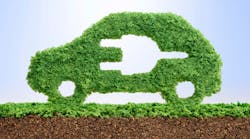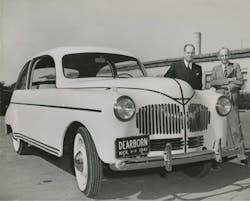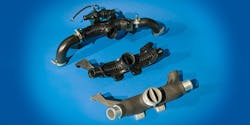"Someday you and I will see the day when auto bodies will be grown down on the farm," Henry Ford said all the way back in 1934. He was referring to a soy milk-based plastic that his namesake company was experimenting with.
As prescient as the manufacturing visionary was, he swung and missed on this one. Not for lack of trying, though. Ford unveiled a prototype soybean car in August 1941, but America's entry into World War II less than four months later snuffed out further development. Ford passed in 1947 and the hope for cars sprouting from soil died with him.
But that dream has been resurrected as shifting as climate change models predicting certain doom—and government fuel economy mandates—have recalibrated the auto industry's focus to sustainability and electric vehicles.
Every major auto OEM has plans for electrifying their vehicles. By now you've probably heard or read about General Motors' restructuring and shuttering five plants to focus on changing consumer tastes--more electrification and less passenger sedans. Tesla is mulling taking one of those, the Lordstown, Ohio plant where the Chevy Cruze is assembled. Ford, now chaired by Henry's great-grandson Bill Ford, has plans to add 40 new models of EVs and hybrids, investing $11 billion by 2022. By the end of the next decade, Bosch projects 30% of new vehicles globally will be hybrid or full-electric.
This has caused the industry to revisit plastics' role in the future of automotive manufacturing. This isn't your parents' plastic though; it's a new strain that replaces petroleum where it can with organic materials, or bioplastics.
Soy: Better Latte than Never
Ford's expansive lineup of sustainable plastics reads like a grocery list: coconut, agave, plastic bottles, rice, tomatoes, wheat, to name a few. And soy, naturally.
Since 2007, the company he founded has used soy polyol foam in its seats and headrests, starting with the 2008 Mustang. Before that, the only soy on the roads was floating in the lattes consumed by hipsters as they commuted to their yoga studio. Never in a Mustang, though, unless it was Chinese takeout.
The project began in 2004 and payed off three years later when the price of oil, used in the production of some 300 lb. of plastic per car, doubled.
Due to the unpredictable cost and availability of oil, Ford Motors' move into bioplastics made sense. It was a point of company pride to realize the early dream of their founder as well. Most importantly to the visionary behind this project, Debbie Mielewski, Ford Motor's Senior Technical Leader for Materials Sustainability, the move to a renewable material has reduced the manufacturer's impact on the planet.
In about a decade's time, Ford has made 18.5 million vehicles with the soy foam, consuming 500 billion soybeans in the process. Mielewski writes that this has "saved more than 228 million pounds of carbon dioxide from entering the atmosphere."
That's the equivalent of what 4 million trees annually would digest, concludes North Carolina State University. Ford says the soy foam reduces their dependence on petroleum oil by 5 million lb./year, or about 50 barrels a day. America consumes nearly 20 million barrels daily, according to the U.S. Energy Information Administration. (Gotta' start somewhere, though, right?)
By itself, the soy plastic savings, which also cut VOCs by 67%, don't amount to many, if any, polar bears saved or hurricanes averted. But it's just one example of how automakers are trying to stay ahead of government-mandated Corporate Average Fuel Economy (CAFE) Standards, which in turn are made to ease humanity's impact on the atmosphere and prevent an Eco-Armageddon. Being "Built Ford Tough" has given way to being gentler to the environment.
For the auto industry to achieve that, manufacturers have to consider every component of the car, just as Ford has considered every way to make plastic. That even includes using the one molecule all these regulations and alternatives are trying to prevent: CO2. in 2016, Ford announced it found a way to convert captured CO2 into foams and plastics that could cut petroleum use by 600 million lb. a year.
"This technology is exciting because it is contributing to solving a seemingly insurmountable problem – climate change," Mielewski says.
Wired for Success
Improving the materials is a key component to pushing EVs from niche luxury item to middle-class daily driver. We covered how private-public partnerships are figuring out how to mass-produce lightweight components like carbon fiber and magnesium, greatly expanding the range and efficiency of EVs. They are costly, though, and unlikely to be affordable enough any time soon. Carbon fiber is 50% lighter than steel, but steel is only 8% the cost of even the least expensive carbon fiber. But steel makes the vehicle heavier and more inefficient, decreasing their range. And range anxiety, while diminishing, still has the power to steer away potential buyers away. It's a vicious cycle for sure.
Check out our investigation into the latest lightweighting trends HERE
DuPont is looking at the lightweighting problem from within, because that's where they are heaviest.
"These motors, batteries and other components are heavy, so OEMs are looking for savings elsewhere which creates tremendous opportunities for more innovative use of plastics and structural adhesives to reduce vehicle weights," says Scott Collick, Global R&D Director, DuPont Transportation & Advanced Polymers.
Tesla's Model 3's lithium ion battery pack weighs more than 1,000 lb., almost 10 times a full gas tank in an average sedan. They don't have an engine or exhaust system, but that's still about an extra 400 lb.
DuPont is working on the supply side of trying to arm OEMs with lighter wiring and electrical systems. He says DuPont's high-performance plastic Zytel HTN (high-temperature nylon) costs less and is lighter than PPS plastics used in wire connectors, wheel motor bobbins and other components. In electric vehicles, this could add up.
Collick says that from its decades of working with the auto industry, DuPont has gleaned that lightweighting works not just in fuel economy but in minimizing brake and tire wear. DuPont also says that shedding 110 lb. off a vehicle reduces up to 5 g of CO2/km and increases fuel economy by up to 2%.
The company is also using its adhesives expertise to drive down the cost of carbon fiber parts. Working with Hyundai, DuPont's lightweight Zytel XT nylon resin and Vamac elastomer reduced the weight of a Turbo Charger Outlet T-Joint by 42% and decreased cost by 35% for the Hyundai Genesis G80 and Kia Stinger, Collick says.
An epoxy resin developed by DuPont called Betaforce was used as the adhesive in a Carbon Fiber Reinforced Plastic (CFRP) rear wall structure on the Audi A8 that is 50% lighter than the previous version.
The good thing is Collick says the combination of adhesives and carbon fiber can be mass-produced. And you wouldn’t think a plastic could compare to the strength of metal, this composite actually has improved torsional stiffness and crash performance.
"When it comes to developing innovative materials for the automotive industry, safety will always be the top priority," Collick says. "Vehicles are designed and tested to perform to worst-case crash standards rather than ideal road conditions."
In other words, no car, no matter how eco-friendly, will hit the roads unless it's safe.
Perhaps the best news Collick reveals is that the pace of all these innovations may make a difference before the recent 2035 deadline scientists announced as "the point of no return," or when he have to act to keep global temps under 2° C.
"On the OEM side, the rapid entry of new manufacturers is increasing the pressure to innovate for the industry as a whole," Collick says. "This pressure creates demand to shorten development cycles for new materials and technology. For example, a recent [Jabil] survey of auto manufacturing decision makers revealed that 75% of OEMs have “shortened” or “significantly shortened” their product development and launch cycles."
It remains to be seen if these actions can ultimately reverse climate change, if that's even within human's control. What cannot be argued is that consumers believe it is a serious threat. A recent Reuters poll found 35% of American adults classify climate change as "an imminent threat. " That's an increase of 11% from 2015 and that will continue to rise. An Axios survey says that three out of every four Millennials want action to be taken to combat climate change. It stands to reason any manufacturer that wants to be taken seriously by consumers in the next decade needs to take an innovative approach to sustainability.
While that may seem like a novel, 21st century approach, it's something Henry Ford was right about all along. Let's hope we can catch up before it's too late.







